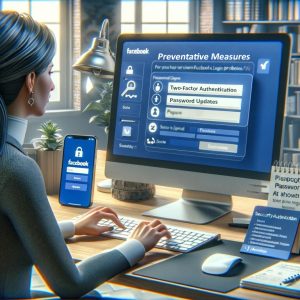Facebook Login Problems
In our digitally connected world, Facebook remains a central hub for both personal connections and professional engagements. This platform enables users to stay in touch with family and friends, share important life updates, and grow their professional network. However, the experience can quickly become frustrating when you encounter Facebook login problems. Common issues like being unable to access your account because you can’t log in to Facebook can disrupt your daily activities and connections.
Many users face typical Facebook login problems that may stem from forgotten credentials or technical errors. Whether it’s issues with the Facebook account login and password or error messages that leave you seeking Facebook help with login, these problems are a significant hurdle for many. Recognizing the need for reliable solutions, our guide aims to address these challenges directly.
We understand how crucial it is to have constant access to your account, both for personal enjoyment and professional necessity. That’s why we’re committed to offering comprehensive assistance. From troubleshooting tips to preventive strategies, we’ll provide step-by-step guidance to resolve common issues related to Facebook login and password. Our goal is to ensure that you can regain access swiftly and secure your account effectively, minimizing disruptions and maximizing your Facebook experience. Stay tuned as we delve into detailed solutions that will help you overcome these login challenges with ease.
Understanding Facebook Login Problems
In today’s interconnected world, having access to your social media accounts is crucial, both for personal connections and professional engagements. Among these platforms, Facebook stands out as a key player, but users often encounter Facebook login problems that can disrupt their daily interactions. This section dives deeper into the nature of these login issues, their causes, and preventive measures to ensure smoother access.
Common Facebook Login Problems
Logging into Facebook seems straightforward until you face an issue that locks you out of your account. Here are several typical Facebook login problems that users might encounter:
-
Forgotten password:
One of the most common issues is forgetting your Facebook login and password. Without these credentials, accessing your account becomes impossible.
-
Account locked or disabled:
For security reasons, Facebook may lock or disable your account if it detects unusual activity, preventing you from logging in.
-
Error messages:
Receiving an “Incorrect Password” or “Invalid Email” message can be particularly frustrating. These messages often indicate either a mistyped entry or deeper Facebook login problems.
Causes of Facebook Login Problems
Identifying the root causes of why you can’t log in to Facebook is crucial for finding the right solution. Here are some common culprits:
-
Browser issues (cookies, cache):
A cluttered browser loaded with cookies and cache can impede your ability to log in, leading to frustrating Facebook login problems.
-
Hacked accounts:
If someone gains unauthorized access to your account and changes your details, it can lead to a complete lockout, prompting a Facebook login issue report.
-
Facebook server problems:
Sometimes, the issue is beyond your control. Server downtimes or glitches can prevent you from accessing your account, leading to error messages stating Facebook can not log in.
Pre-Login Checks for Facebook
Performing a few quick checks before attempting to log in can save you a lot of time and trouble:
-
Checking Facebook server status:
Before diving into deeper troubleshooting, it’s wise to check if Facebook itself is experiencing issues. Websites like Down detector can provide real-time status updates and user reports if you suspect a server problem.
-
Ensuring browser compatibility and updates:
An out-dated or incompatible browser can often be the root of Facebook login problems. Make sure your browser is up to date, and consider switching to a more stable browser if login issues persist.
Understanding and resolving Facebook login problems requires a thorough approach—from recognizing common login issues and their causes to performing essential pre-login checks. This comprehensive understanding not only helps in effectively troubleshooting the problems but also in preventing future issues. If you continue to face difficulties, do not hesitate to use the Facebook help with login feature or report your issues through official channels. Remember, most Facebook login problems are solvable, and with right knowledge, you can quickly regain access to your account.
Solutions for Facebook Login Problems
Navigating Facebook login problems can be a daunting task, but with the right guidance, regaining access to your account is manageable. This section provides detailed, step-by-step solutions to the most common issues related to your Facebook account login and password.
Recovering Your Facebook Account
-
How to Reset Your Facebook Password
If you’ve forgot your Facebook login and password, resetting it is straightforward. Follow these steps to reset your password Facebook login efficiently:
-
- Go to Facebook login page and click on ‘Forgot Password?’
- Enter email address or phone number linked to your account to search for your account.
- Choose your recovery option (email or SMS) to receive the reset code.
- Enter the code received and set your new password.
Remember, choosing a strong password that combines letters, numbers, and symbols can significantly enhance your account’s security.
-
Retrieving Facebook Account with Recovery Options
If you have Facebook login account password forgot, there are additional ways to recover it:
-
- Use an alternative email or phone number set up previously.
- Answer your security question, if you set one up.
- Ask friends for help if you’ve set up Trusted Contacts.
These options provide an alternative route to regain access if the standard password reset does not work.
Dealing with Locked or Disabled Facebook Accounts
-
Reasons for Facebook Account Locking
Accounts may be locked or disabled for several reasons, such as:
-
- Suspicious activity or an attempted breach.
- Violations of Facebook’s community standards.
- Repeated wrong attempts to enter a Facebook login username and password.
-
Steps to Restore Facebook Account Access
To recover access to a locked or disabled account:
-
- Visit the Facebook Help Center and find the ‘My Account Is Locked’ section.
- Follow prompts to verify your identity, which might include identifying friends in pictures or providing your date of birth.
- Submit a formal appeal if your account was disabled by mistake, detailing why you believe it’s an error.
Troubleshooting Browser & Facebook App Issues
-
Clearing Cache and Cookies
A simple yet effective way to resolve Facebook login problems is to clear your browser’s cache and cookies. This can fix issues like slow loading times and Facebook can not log in errors:
-
- Open your browser settings.
- Navigate to ‘Privacy and Security.’
- Select ‘Clear browsing data’ and choose to clear cookies and cache.
-
Updating the Facebook App and Troubleshooting Mobile Issues
Keeping your app updated is crucial for security and functionality:
-
- Check app store for any available updates for the Facebook.
- If problems persist, try uninstalling and reinstalling Facebook app to clear residual data.
Following these steps will help ensure that technical glitches interfering with your Facebook login and password are minimized. Always ensure you have latest version of the app and your browser to maintain optimal performance and security settings.
Advanced Solutions for Facebook Login Problems
When facing persistent Facebook login problems, advanced solutions techniques provide deeper resolution strategies. This section explores the utilization of Facebook’s Trusted Contacts feature and the legal avenues available when dealing with compromised accounts, ensuring you can navigate these issues with the necessary tools and knowledge.
Using Facebook’s Trusted Contacts Feature
Trusted Contacts is an innovative security feature from Facebook designed to help you regain access to your account through the assistance of close friends. Below are detailed steps on how to set up this feature and use it effectively:
Setting up Trusted Contacts
-
- Log into Facebook account and navigate to the security settings.
- Locate and select the ‘Trusted Contacts’ option, then choose 3 to 5 friends whom you trust implicitly. These friends should be ones you can rely on to help if you ever have trouble logging in.
- Once set up, your chosen friends will be equipped to assist you in the event you need help with Facebook login id recovery.
How to Login Using Trusted Contacts
Should you encounter a situation where you can not log in or have facebook login problems:
-
- Visit the Facebook login page, click on ‘Forgot account?’ and input your profile information to search for your profile.
- Follow the prompt to ‘Use Trusted Contacts’ and select a method to receive recovery codes from them.
- Input the recovery codes provided by your contacts to regain access to your account.
Leveraging Trusted Contacts can be particularly valuable if standard recovery options are inaccessible or have been altered due to unauthorized access.
Legal Recourse for Hacked Facebook Accounts
Experiencing a hacked account is distressing and poses a significant threat to your personal data and security. Here are crucial steps and legal measures you can take if your account is compromised:
What to Do if You Suspect Your Account Has Been Hacked
-
- Change your Facebook login and password immediately, if you still have access to your account.
- Utilize Facebook’s support options to report a login issue Facebook. This tool is specifically designed to handle security breaches.
- Check your account’s recent activity to identify and reverse any unauthorized changes or actions.
- Alert your friends and family that your account has been hacked to prevent them from falling victim to scams perpetrated under your identity. If your account still hasn’t been recovered, we recommend reading our comprehensive blog on Facebook account hacking.
Legal Protections and Recourse
-
- Compile all evidence related to the hack, including any unusual activity or messages sent without your consent.
- Speak with legal expert who specializes in cyber law to understand your rights and the potential for legal action to protect your identity and personal data.
- Depending on your location, you may be able to report the incident to local law enforcement or a national cybercrime unit.
Understanding these advanced troubleshooting techniques and knowing your legal options are essential when addressing severe Facebook login problems or security breaches. By effectively using Facebook help with login or pursuing legal actions, you can safeguard your online presence. Proactive security measures are crucial for maintaining the integrity and safety of your Facebook login username and password.
Preventative Measures for Facebook Login Problems
Securing your Facebook account is paramount to ensure a safe and uninterrupted social media experience. This section covers essential preventative measures and best practices that help you protect your account from unauthorized access and address Facebook login problems before they occur.
Creating a Strong Facebook Password
A strong password is your first line of defence against unauthorized access to your account. Here are tips for crafting and remembering robust passwords:
-
Complexity is Key:
Your Facebook login and password should be long (at least 12 characters) a combination of symbols, numerals, and capital and lowercase letters.
-
Avoid Common Words:
Simple and commonly used passwords are easy to hack. Avoid sequences like “12345” or “password”.
-
Use a Passphrase:
Consider using a memorable phrase or a combination of words that are significant only to you but hard for others to guess.
-
Password Managers:
Utilize a password manager to generate and store complex passwords. This tool helps in managing different passwords for various sites without the need to remember each one.
-
Update Regularly:
Even strong passwords should be changed periodically. Set a reminder to update your Facebook login password every few months, especially if you hear news of a data breach.
Implementing these strategies not only enhances your security but also helps in situations where you might otherwise Facebook login check password or can not log in due to forgotten credentials.
Facebook Two-Factor Authentication
Two-factor authentication (2FA) adds a extra layer of security by needed two forms of identification before you can log in. Here’s how to set it up and the benefits it brings:
-
Setting Up 2FA:
Go to your Facebook settings, navigate to the security section, and select ‘Use two-factor authentication.’ You can choose from several methods, such as a text message code to your phone or an app that generates codes.
-
Benefits of 2FA:
With 2FA, even if someone discovers your password, they won’t be able to access your account without the second factor. This significantly reduces the risk of unwanted access, providing additional security against potential Facebook login problems.
Regularly Updating Facebook Account Details
Keeping your account details current is crucial for account recovery and security maintenance:
-
Update Recovery Options:
Always ensure your email addresses and phone numbers are up-to-date. These are vital if you ever need to reset your Facebook account login password or recover your account.
-
Security Settings Review:
Regularly check your security settings to ensure they meet your needs. Look for any unfamiliar devices or locations that have accessed your account.
-
Be Proactive:
Regular updates and reviews can prevent scenarios where you might face Facebook login problems or need sign in help due to out-dated information.
By adopting these best practices—creating a strong password, enabling two-factor authentication, and regularly updating your account details—you safeguard your online presence against unauthorized access and reduce the likelihood of experiencing Facebook login problems. These measures are essential for anyone looking to secure their Facebook login username and password effectively.
FAQs
Q1. What should I do if I forgot my Facebook login and password?
- A. If you’ve forgot your Facebook login and password, you can reset it by going to the Facebook login page, clicking “Forgot Password?”, and following the instructions to reset password Facebook login. You’ll need access to the email or phone number associated with your account.
Q2. How often should I change my Facebook login account password for security reasons?
- A. It’s good practice to change your Facebook login account password periodically, such as every three to six months. This is especially important if you suspect any security vulnerability or if you’ve shared your Facebook sign in password with anyone.
Q3. Why can’t I log in to my Facebook account despite having the correct credentials?
- A. If you have the correct Facebook account login password but I can’t log in to Facebook, check for any server issues, update your browser, or clear your browser’s cache and cookies. This often resolves temporary login issues.
Q4. What actions can I take to secure my Facebook login and password?
- A. To secure your Facebook login and password, use a strong, unique password, enable two-factor authentication, and regularly update your recovery information. Regularly reviewing your security settings can also help prevent unauthorized access.
Q5. How do I report a login issue to Facebook?
- A. You can report a login issue Facebook by navigating to the Help Center and following the prompts for login issues. This helps Facebook identify and resolve your specific problem more efficiently.
Q6. What is Facebook’s Trusted Contacts feature and how does it help with Facebook login id recovery?
- A. Facebook’s Trusted Contacts feature allows you to choose friends who can help you regain access if you’re locked out. If you Facebook login account password forgot, you can request a recovery code from your Trusted Contacts to recover your account.
Q7. How do I get my Facebook account back if I no longer have access to the email or phone number listed on it?
- A. If you’ve lost access to the email or phone associated with your account and need to perform Facebook login id recovery, you can try to recover your account using alternate email or phone number that you previously added. If that’s not available, Facebook’s Help me login to Facebook feature provides additional recovery options.
Q8. I think my account has been hacked. What should I do to regain control of my Facebook login and password?
- A. If you suspect hacking, immediately change your Facebook login in password and report the compromise through the login issue Facebook portal. Check your account activity for any unauthorized modifications and alert your contacts.
Q9. What should I do if I receive an error message stating “Facebook can not log in” when I try to sign in?
- A. If you see the message Facebook can not log in, check Facebook’s server status, ensure your account is not disabled, and confirm you are using the correct Facebook sign in password. Also, consider trying a different device or network to isolate the issue.
Q10. How do I change my Facebook login account password if I remember the old one?
- A. If you remember your old Facebook login password and wish to change it, go to Settings > Security and Login > Change password. Enter your old password, then create new one following best practices for strong passwords.
Conclusion
Throughout this guide, we have explored a variety of strategies to resolve Facebook login issues effectively. From understanding common login complications to implementing advanced troubleshooting techniques and preventive measures, we have provided comprehensive insights to help you fix Facebook login problems efficiently.
Facebook login troubleshooting is crucial not only for regaining access but also for maintaining the security of your account. The importance of creating robust passwords, enabling two-factor authentication, and keeping your account details up-to-date cannot be overstated. Each of these actions plays a vital role in safeguarding your Facebook login and password, ensuring that you can not log in only when you choose to, not because of security breaches or technical issues.
We encourage you to continue practicing these secure login habits. Regularly check your Facebook login password and update it, monitor your account for any unauthorized access, and employ the security features Facebook provides. By doing so, you enhance your defenses against potential threats and reduce the likelihood of facing Facebook login problems.
We invite you to share your experiences and any further questions you might have in the comments below. Whether you’ve encountered specific challenges in managing your Facebook login username and password, or have tips on additional preventative measures, your contributions can help foster a community of informed and secure Facebook users.
To know more about Facebook login problemsand resolve its related issues, please visit Facebook Support page.

Patricia mitchell
What should I do if I’ve tried multiple times to reset my Facebook account login and password through the reset password Facebook login feature, but none of the emails or text messages with the reset code have arrived in my inbox or phone?
Support Admin
When you encounter difficulties receiving a reset code via email or SMS after attempting to reset your Facebook account login and password through the reset password Facebook login feature, consider the following steps:
1. Double-check the spam or junk folder of your email account for any messages from Facebook, as these can sometimes be misdirected by your email provider.
2. Ensure that the phone number linked to your Facebook account is current and capable of receiving SMS messages.
3. Retry the password reset process, making sure to accurately enter your email or phone number associated with your Facebook account.
4. If you’re still not receiving the reset code, navigate to the Facebook help with login page and look for alternative methods to verify your identity, which might include answering security questions or providing additional identification proof.
5. As a precaution, update your security settings once you regain access to enhance future recoveries and reduce the risk of similar issues.